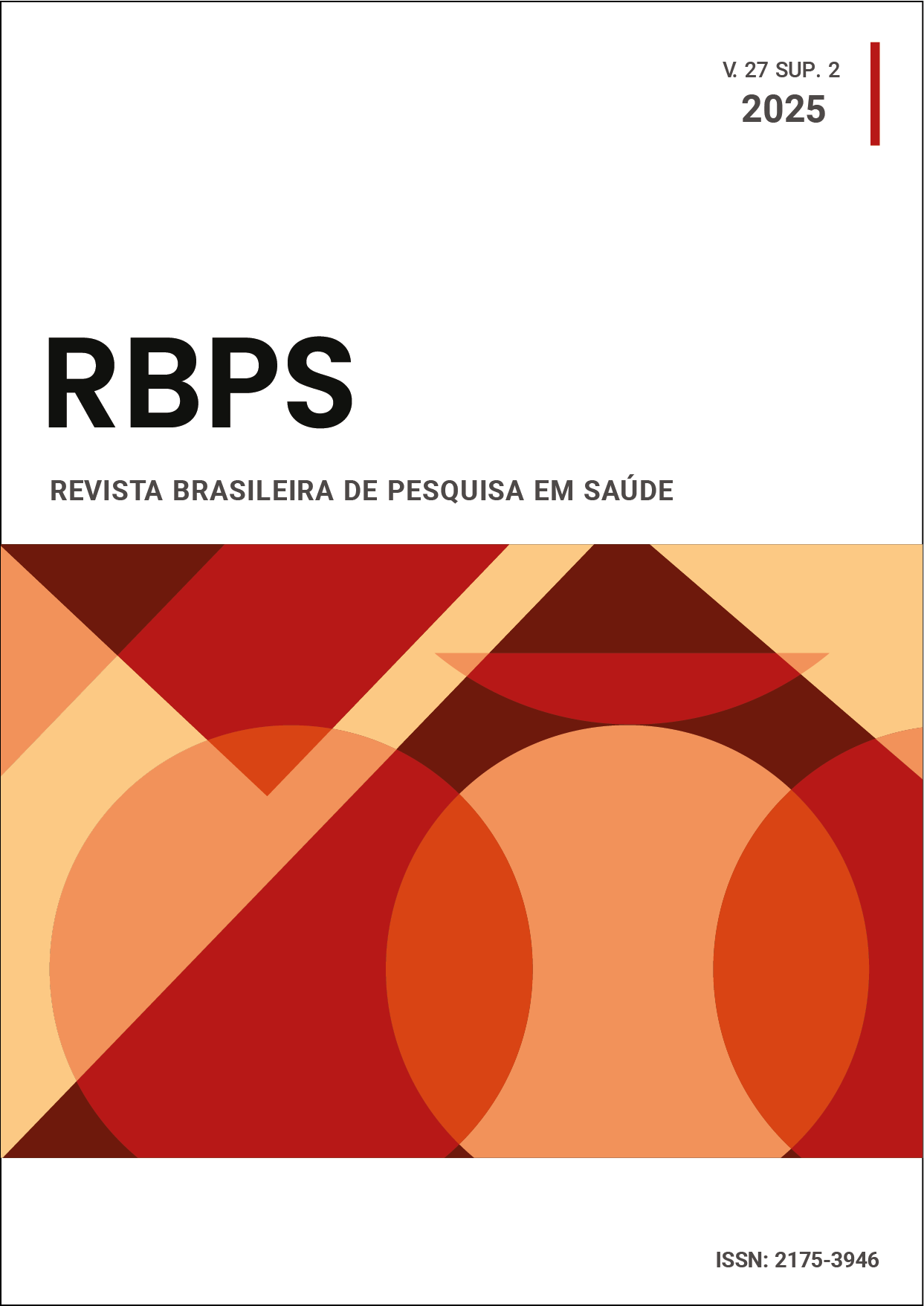Violência por parceiro íntimo e comportamento alimentar de mulheres adultas
síntese narrativa de evidências recentes
DOI:
https://doi.org/10.47456/rbps.v27isupl_2.48419Palavras-chave:
Violência por parceiro íntimo, Violência contra a mulher, Comportamento alimentar, Comportamento alimentar desordenadoResumo
Introdução: A violência por parceiro íntimo é uma importante questão de saúde pública e afeta desproporcionalmente as mulheres, estando associada a múltiplos desfechos negativos para a saúde física e mental. Objetivo: Realizar uma revisão narrativa da literatura científica sobre a relação entre violência por parceiro íntimo (VPI) e o comportamento alimentar em mulheres adultas. Métodos: Utilizaram-se as bases PubMed, SciELO e LILACS para a busca dos artigos, incluindo estudos publicados entre 2015 e 2025. Resultados: Dos 30 artigos identificados, cinco atenderam aos critérios de inclusão. Os achados revelam que a VPI está relacionada a alterações significativas no comportamento alimentar, como compulsão, perda de apetite, ingestão alimentar emocional, retaliação alimentar e desenvolvimento de transtornos alimentares, frequentemente mediadas por mecanismos psicológicos. Conclusão: A escassez de estudos sobre o tema evidencia a necessidade de aprofundamento científico e de um olhar interdisciplinar por parte dos profissionais de saúde para a identificação e o manejo sensível dessas demandas.
Downloads
Referências
Chen S, Ma N, Kong Y, Chen Z, Niyi JL, Karoli P, et al. Prevalence, disparities, and trends in intimate partner violence against women living in urban slums in 34 low-income and middle-income countries: a multi-country cross-sectional study. E Clin Med. 2025;81:103140.
Leemis RW, Friar N, Khatiwada S, Chen MS, Kresnow M, Smith SG, et al. The National Intimate Partner and Sexual Violence Survey: 2016/2017 Report on Intimate Partner Violence. Atlanta, GA: National Center for Injury Prevention and Control, Centers for Disease Control and Prevention; 2022.
United Nations. Declaration on the elimination of violence against women. New York: United Nations; 1993.
World Health Organization. Global plan of action to strengthen the role of the health system within a national multisectoral response to address interpersonal violence, in particular against women and girls, and against children. Geneva: WHO; 2016.
World Health Organization. Violence against women prevalence estimates, 2018: global, regional and national prevalence estimates for intimate partner violence against women and global and regional prevalence estimates for non-partner sexual violence against women. Geneva: WHO; 2021.
Garcia LP, Silva GDM. Violência por parceiro íntimo: perfil dos atendimentos em serviços de urgência e emergência nas capitais dos estados brasileiros, 2014. Cad Saúde Pública. 2018;34(4):e00047317.
Vasconcelos NM, Andrade FMD, Gomes CS, Pinto IV, Malta DC. Prevalence and factors associated with intimate partner violence against adult women in Brazil: National Survey of Health, 2019. Rev Bras Epidemiol. 2021;24(2):e210020.
Leite FMC, Amorim MHC, Wehrmeister FC, et al. Violence against women, Espírito Santo, Brazil. Rev Saúde Pública. 2017;51:33.
Santos IB, Leite FMC, Amorim MHC, Maciel PMA, Gigante DP. Violência contra a mulher na vida: estudo entre usuárias da Atenção Primária. Ciênc Saúde Colet. 2020;25(5):1935–46.
Baumont AS, Oliveira GS, Figueiredo JB, et al. Intimate partner violence and women’s mental health during the COVID-19 pandemic in Brazil. Trends Psychiatry Psychother. 2024;46:e20220594.
Spencer CN, Khalil M, Aravkin AY, et al. Health effects associated with exposure to intimate partner violence against women and childhood sexual abuse: a burden of proof study. Nat Med. 2023;29(12):3243–58.
Siqueira LLC, Batista KM, Leite FMC. Association between perceived stress and history of intimate partner violence throughout life and during the COVID-19 pandemic. Front Public Health. 2023;11:1330451.
Audibert SA, Leite FMC, Malta DV, Freitas EMLM, Santos DF. Repercussões da violência na qualidade de vida das mulheres: uma revisão narrativa. RBPS. 2025;27(1):146–54.
Meyer SR, Mosha N, Hatcher AM, et al. Food insecurity and intimate partner violence in Mwanza, Tanzania: a longitudinal analysis. Am J Prev Med. 2023;65(5):932–9.
Burnatowska E, Surma S, Olszanecka-Glinianowicz M. Relationship between mental health and emotional eating during the COVID-19 pandemic: a systematic review. Nutrients. 2022;14(19):3989.
Fonseca RMGS, Leal MC, Oliveira DC, Santos WS, Silva EB, Machado LS, et al. Violência por parceiro íntimo contra a mulher e insegurança alimentar: uma revisão narrativa da literatura. Interface (Botucatu). 2022;26:e210488.
Klotz-Silva J, Prado SD, Seixas CM. Do que estamos falando? Comportamento alimentar no campo da Alimentação e Nutrição. Physis. 2016;26(4):1103–23.
Hill D, Conner M, Clancy F, Moss R, Wilding S, Bristow M, O'Connor DB. Stress and eating behaviours in healthy adults: a systematic review and meta-analysis. Health Psychol Rev. 2022;16(2):280–304.
Macht M, Roth S, Ellgring H. Chocolate eating in healthy men during experimentally induced sadness and joy. Appetite. 2002;39(2):147–58.
Van Strien T, Herman CP, Verheijden MW. Eating style, overeating, and overweight in a representative Dutch sample: does external eating play a role? Appetite. 2009;52(2):380–7.
Bongers P, Jansen A, Houben K, Roefs A. Happy eating: the single target implicit association test predicts overeating after positive emotions. Eat Behav. 2013;14(3):348–55.
Sabry SD, Carioca AAF, Arruda SPM, Adriano LS, Sampaio HA de C. Adaptação transcultural e avaliação de propriedades psicométricas do Emotional Appetite Questionnaire em mulheres de língua portuguesa. Ciênc Saúde Colet. 2020;25(7):1–11.
Van Strien T, Cebolla A, Etchemendy E, et al. Emotional eating and food intake after sadness and joy. Appetite. 2013;66:20–5.
Van Strien T, Donker MH, Ouwens MA. Is desire to eat in response to positive emotions an 'obese' eating style: is Kummerspeck for some people a misnomer? Appetite. 2016;100:225–35.
American Psychiatric Association. Diagnostic and Statistical Manual of Mental Disorders. 5th ed. Text Revision (DSM-5-TR). Arlington, VA: American Psychiatric Publishing; 2022.
Vahedi L, Orjuela-Grimm M, Chan PM, Meyer SR. Intimate partner violence and women’s dietary diversity: a population-based investigation in 8 low- and middle-income countries. J Nutr. 2025;155(4):1236–45.
Kimber M, McTavish JR, Couturier J, et al. Consequences of child emotional abuse, emotional neglect and exposure to intimate partner violence for eating disorders: a systematic critical review. BMC Psychol. 2017;5:33.
Wong SPY, Chang JC. Altered eating behaviors in female victims of intimate partner violence. SAGE Open. 2015;1–16.
Bartlett BA, Iverson KM, Mitchell KS. Intimate partner violence and disordered eating among male and female veterans. Psychiatry Res. 2018;260:98–104.
Odini F, Amuzie C, Kalu KU, et al. Prevalence, pattern and predictors of intimate partner violence amongst female undergraduates in Abia State, Nigeria: public health implications. BMC Womens Health. 2024;24:259.
Yoon C, Emery RL, Hazard VM. Adverse experiences as predictors of maladaptive and adaptive eating: findings from EAT 2018. Eat Behav. 2022;46:105737.
Silva L, Oliveira ML, Santos A. Aspectos psicológicos de mulheres que sofrem violência sexual. Rev Psiquiatr Clín. 2013;40(1):34–9.
Bretrana I, Mendia J, Díaz-Gorriti V, Rotaetxe O. Intimate partner violence and eating disorders: a systematic review. Curr Psychol. 2025;44:1696–716.
Norman RE, Byambaa M, De R, Butchart A, Scott J, Vos T. The long-term health consequences of child physical abuse, emotional abuse, and neglect: a systematic review and meta-analysis. PLoS Med. 2012;9(11):e1001349.
Andrade CR, Avanci JQ, Oliveira RVC. Experiências adversas na infância, características sociodemográficas e sintomas de depressão em adolescentes de um município do Rio de Janeiro, Brasil. Cad Saúde Pública. 2022;38(6):e00269921.
Hazzard VM, Bauer KW, Mukherjee B, et al. Associations between childhood maltreatment latent classes and eating disorders symptoms in a nationally representative sample of young adults in the United States. Child Abuse Negl. 2019;98:104171.
Downloads
Publicado
Edição
Seção
Licença
Copyright (c) 2025 Revista Brasileira de Pesquisa em Saúde/Brazilian Journal of Health Research

Este trabalho está licenciado sob uma licença Creative Commons Attribution-NonCommercial-NoDerivatives 4.0 International License.
A Revista Brasileira de Pesquisa em Saúde (RBPS) adota a licença CC-BY-NC 4.0, o que significa que os autores mantêm os direitos autorais de seus trabalhos submetidos à revista. Os autores são responsáveis por declarar que sua contribuição é um manuscrito original, que não foi publicado anteriormente e que não está em processo de submissão em outra revista científica simultaneamente. Ao submeter o manuscrito, os autores concedem à RBPS o direito exclusivo de primeira publicação, que passará por revisão por pares.
Os autores têm autorização para firmar contratos adicionais para distribuição não exclusiva da versão publicada pela RBPS (por exemplo, em repositórios institucionais ou como capítulo de livro), desde que seja feito o devido reconhecimento de autoria e de publicação inicial pela RBPS. Além disso, os autores são incentivados a disponibilizar seu trabalho online (por exemplo, em repositórios institucionais ou em suas páginas pessoais) após a publicação inicial na revista, com a devida citação de autoria e da publicação original pela RBPS.
Assim, de acordo com a licença CC-BY-NC 4.0, os leitores têm o direito de:
- Compartilhar — copiar e redistribuir o material em qualquer suporte ou formato;
- Adaptar — remixar, transformar, e criar a partir do material.
O licenciante não pode revogar estes direitos desde que você respeite os termos da licença. De acordo com os termos seguintes:
- Atribuição — Você deve dar o crédito apropriado, prover um link para a licença e indicar se mudanças foram feitas. Você deve fazê-lo em qualquer circunstância razoável, mas de maneira alguma que sugira ao licenciante a apoiar você ou o seu uso.
- Não Comercial — Você não pode usar o material para fins comerciais.
- Sem restrições adicionais — Você não pode aplicar termos jurídicos ou medidas de caráter tecnológico que restrinjam legalmente outros de fazerem algo que a licença permita.

























